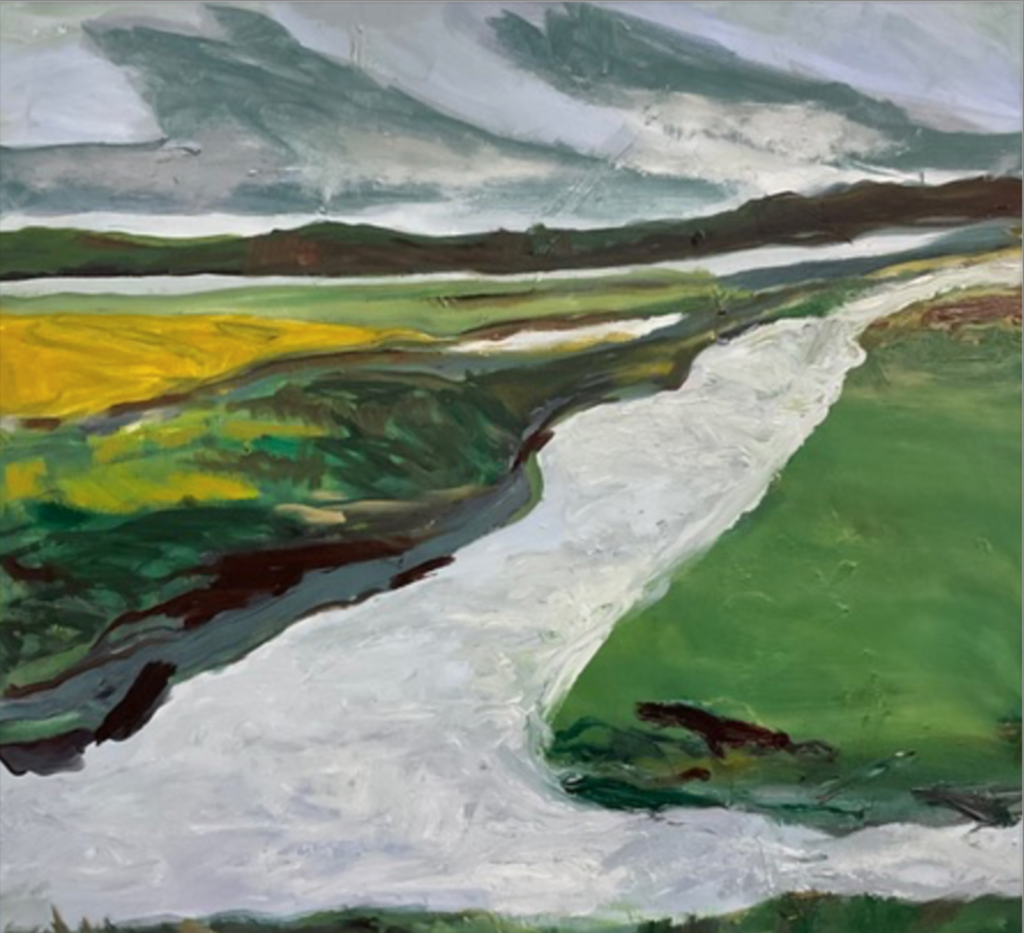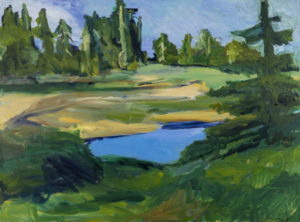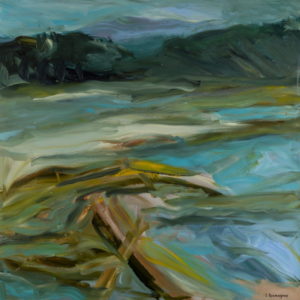
By Oregon ArtsWatch
Should you be driving along Yaquina Bay Road east of Newport and find yourself tootling along behind a green Subaru, before you hit the horn or flash that universally understood gesture, consider — you may be following a renowned artist at work.
That would be Sandra Roumagoux, prominent Oregon painter, three-time mayor of Newport, educator, activist and an engaging storyteller in her own right.
She’s also the featured artist at the Newport Performing Arts Center’s new Olive Street Gallery, the exhibit titled, aptly enough, “Tide Flats Along the Yaquina Bay Road.”
“This time of year, I like driving in the evening around 6 p.m. with the windows down to feel the wind and to smell the tide flats,” she said. “I had an instructor that said you almost have to internally feel. You have to know you squished that mud through your fingers, stood out there and felt the wind and rain. When you get that insight and it’s internalized you can paint it.”

Born in Yakima, Wash., Roumagoux was 9 when her fourth-generation Oregonian dad bought property near Camp Adair and moved the family to the Willamette Valley. Summers found her on the coast harvesting oysters and digging bay clams with her mother, who occasionally needed assistance off the mud.
At home, her parents made nature, political involvement and wildlife – for better or worse — part of everyday life.
She met her husband-to-be, Dan Roumagoux, at Oregon State University on a blind date and married him in the spring of 1959. The pair moved south, where Roumagoux earned a master’s degree in fine arts at the University of Arkansas, and later taught.
Once, driving the back roads of Arkansas and in need of a rest stop, she spotted what she believed to be a country craft show. Then she spotted the child-sized Klan outfits.
“That, plus the evil stares, I was getting out of there fast,” she recalled. “Later, I was talking to colleagues, and they said, ‘Gosh, Sandy how can you go out and get yourself into so much trouble.’”
To Oregon and coastal tide flats

So, back to Oregon it was, this time to Newport and the tide flats, where she developed an “obsession” with the tires littering the mud, as ubiquitous as the natural flora.
Four of her tire-littered landscapes, each about 50 inches by 80 inches, are now part of permanent collections: Portland Art Museum; Oregon State University Policy Building in Corvallis; Thompson’s Sanitary Service in Newport; Hatfield Marine Science Center in Newport. Another of the paintings was included in Visual Magic: An Oregon Invitational, at the Jordan Schnitzer Museum of Art in Eugene in 2019.
But Roumagoux’s focus began shifting. “I will follow an idea through until I don’t know what else to do with it,” she said. “That’s when I get obsessed with something else. My life is one obsession after another, the only way to live.”
As Roumagoux studied the flats, she began noticing the patterns between high and low tides, the natural channels carved out by the ocean that “almost look like they were engineered in some other culture.” Her drives along Yaquina Bay Road became more frequent, and she began to see how the landscape transformed with the changing tides.
“You have a full tide, and it floods the land, and you don’t know what’s under there — maybe a few bits of grass on the higher parts. At low tide, I see the dark colored mud, roots of the grasses … crab tracks, clam air holes … The smell is really noticeable at low tide. Many think it is a stink smell; I find it earthy. That’s when I got off my tires and onto the tide flats. I thought about how to compose the image and how would I handle it interpretation-wise? Would I go for more realistic or impressionistic, more gestural in my approach? I just fell in love with them. There is a connection there for me.”
Recovering from illness

Last fall a grave diagnosis brought her daily drives to a halt, her future as an artist suddenly as questionable as her own life. In December, she underwent a 12-hour Whipple procedure to remove tumors from her duodenum.
She came home from the Portland hospital on Christmas eve, “tubed up,” making any movement “precarious at best.” Her daughters, fifth-generation Oregonians Charmaine and Ramona, helped out around the house and beyond, including ferrying their mom to the tide flats. By March, Roumagoux was back in the driver’s seat.
“Both daughters held their respective breaths when I took the wheel, sure that they would be blamed if I ended up driving off the road resulting in a close up of the tide flats.”
But recovery would be difficult, there was no question about it. Roumagoux would have to relearn even the basics. But would she be able to paint again? She didn’t know. She was troubled by tremors and while once accustomed to standing for three hours at a time, she could now manage only a fraction of that.
But when she picked up the brush … “That energy was immediately accessible to me,” she said. “That was a gift I hadn’t expected … It was just right there. The art gods, you know, they reward you every once in a while. It just falls out of the brush. It’s there. It’s you. It just goes and you don’t know where it comes from.”
Roumagoux is only the second artist to be exhibited in the newly christened space, meant to showcase local artists and also as a link to the Visual Arts Center blocks away, said Jason Holland, executive director for the Oregon Coast Council for the Arts.
“I think the scale of these pieces just looks beautiful on these walls,” Holland said. “They are really large. One of the things I love is hearing people when they stand in front of them and recognize the vista, and they say, ‘Oh, I know where this is.’ There is something about that that is really special.”
The surgery has altered Roumagoux’s perspective — about time, the future, the importance of a single day. She lost her husband in 2019, just short of 60 years of marriage. After his death, she bought a house in one of the older neighborhoods of Newport, then spent a year overseeing the remodel, including a former garage-turned-studio colored with tubes of paints, new paintings still in the works and shelves of antlers, skulls and bones students have brought to Roumagoux over the years.
At 81, she’s the oldest at any gathering, and yet, it seems just yesterday she was a teen. Where long-term planning once meant 10 years, she now thinks in shorter terms: six months, a year.

Earlier this year, the Creative Arts Community awarded Roumagoux a Founders Scholarship to the Menucha Retreat and Conference Center in Corbett. In announcing the award, the CAC wrote:
“The award is not given each year, nor is it received by application. The group bestows it only when deemed appropriate upon a person who has provided wide and significant influence in the arts community.”
After the workshop, where she’ll work with Portland artist Mary Josephson, she plans to prepare for a fall 2023 exhibit at the Lincoln City Cultural Center. They’ve asked for at least 15 paintings.
“A year for that many is just huffing right along,” Roumagoux said. “I paint over paintings a lot. I’ll think it’s OK, then I let them cool for a time and then if I don’t think it’s OK; I get into major surgery with the brush.
“I’m still interested in tide flats. It’s also about myself. That’s been really interesting for me to see. The older I get the longer I’ll stay with a subject. That’s one of the benefits of age. Like Auntie Mame. I’ve been one who wants to eat everything all at once. Now, it’s like I don’t care. I am going to do what satisfies me and know that I’ll have enough to eat.”
- This story was originally published by news partner Oregon ArtsWatch. It is supported in part by a grant from the Oregon Cultural Trust, investing in Oregon’s arts, humanities and heritage, and the Lincoln County Cultural Coalition. For more arts news coverage go to Oregon ArtsWatch




Thanks for the great story on Sandy and her talent!